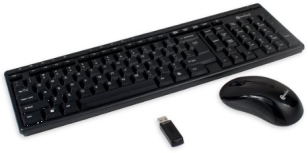In order to eliminate some of the cable tangle associated with PC's and allow operating a keyboard and mouse as far as six feet from the PC, some people use a wireless keyboard and mouse. A wireless input device such as a keyboard or mouse uses a built-in radio transceiver to communicate with a similar transceiver plugged into a USB port on a PC.
Many wireless input devices use a 27 MHz frequency that has a range of about 6 feet. FastRF is a wireless input technology that uses a 2.4 GHz frequency to transmit data 125 times per second making it operate as smooth as a cabled keyboard or mouse.
Wireless input devices pose several problems. One is the possible cancer causing affect of having a high-frequency radio device in the palm of your hand. The other is that it's easy for eaves droppers to pick up your keystrokes and steal your information and passwords.
Logitech's newer wireless keyboards have a security feature that uses 4000 possible different digital security codes to prevent someone else from picking up your signal. Most modern wireless keyboards and mouse use the 2.4 GHz Bluetooth standard. Bluetooth has range of up to 30 feet and it encrypts the signal to provide the highest security.
Troubleshooting Wireless Input Devices
1. Resynchronize your device. Some devices have Reset or Connect button on the bottom of the device. Also try removing and reinserting the batteries.
2. Make sure transceiver is properly installed to USB port. If your device is already connected to a USB port on the computer, try to connect the device to a different USB port if one is available.
3. Make sure device's battery is good. Install a fresh set of batteries in the device.
4. Check for interference. Electronic devices such as microwaves, cell phones, radios, fans or fluorescent lights can interfere with wireless devices. Other wireless devices like wireless routers and wireless keyboard or mouse on nearby PC can also interfere. Change the location of the PC in relation to these devices.
5. A recent automatic update may be incompatible with the device. Download and install the latest software or driver from the device manufacturer's website.
6. Try the device on a different PC. If the device works on another PC, the problem is with the first PC. If the device does not work on another PC, it may be a defective device.

Learn more at amazon.com
More Windows Troubleshooting Articles:
• Fix 0x80070035 Error on a Windows PC
• How to Resolve Cable, DSL, and Dialup Modem Problems
• Understanding the boot.ini File
• How To Fix pnrpsvc.dll Error
• Troubleshooting Windows 7 Inside Out
• How To Fix The Windows 1301 Error
• Free Firewall - ZoneAlarm
• How to Troubleshoot Your Computer's Mouse
• Undoing a Windows Update
• Fix Windows 7 Repeatedly Tries to Update


